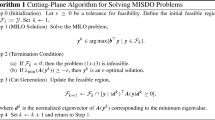Abstract
We consider the minimum compliance topology design problem with a volume constraint and discrete design variables. In particular, our interest is to provide global optimal designs to a challenging benchmark example proposed by Zhou and Rozvany. Global optimality is achieved by an implementation of a local branching method in which the subproblems are solved by a special purpose nonlinear branch-and-cut algorithm. The convergence rate of the branch-and-cut method is improved by strengthening the problem formulation with valid linear inequalities and variable fixing techniques. With the proposed algorithms, we find global optimal designs for several values on the available volume. These designs can be used to validate other methods and heuristics for the considered class of problems.











Similar content being viewed by others
Notes
There is an ambiguity with the word node, since it can also refer to a finite element node. Throughout this paper, unless explicitly stated, a node refers to a part of the enumeration tree.
By hidden solutions, we mean optimal designs that are found, by the heuristics, at great depths in the search tree.
References
Achterberg T, Koch T, Martin A (2005) Branching rules revisited. Oper Res Lett 33:42–54
Achtziger W (1998) Multiple load truss topology and sizing optimization: some properties of minimax compliance. J Optim Theory Appl 98:255–280
Achtziger W, Stolpe M (2007) Truss topology optimization with discrete design variables—guaranteed global optimality and benchmark examples. Struct Multidisc Optim 34(1):1–20
Achtziger W, Stolpe M (2008) Global optimization of truss topology with discrete bar areas—Part I: Theory of relaxed problems. Comput Optim Appl 40(2):247–280
Achtziger W, Stolpe M (2009) Global optimization of truss topology with discrete bar areas—Part II: Implementation and numerical results. Comput Optim Appl 44(2):315–341
Achtziger W, Bendsøe M, Ben-Tal A, Zowe J (1992) Equivalent displacement based formulations for maximum strength truss topology design. Impact Comput Sci Eng 4:315–345
Ben-Tal A, Bendsøe M (1993) A new method for optimal truss topology design. SIAM J Optim 3(2):322–358
Bendsøe M, Sigmund O (2003) Topology Optimization—theory, methods and applications. Springer
Bourdin B (2001) Filters in topology optimization. Int J Numer Methods Eng 50(9):2143–2158
Cook R, Malkus D, Plesha M (1989) Concepts and applications of finite element analysis, 3rd edn. Wiley
Fischetti M, Lodi A (2003) Local branching. Math Program 98(1–3): 23–47
Gill P, Murray W, Saunders M (2002) SNOPT: an SQP algorithm for large-scale constrained optimization. SIAM J Optim 12(4):979–1006
Haber R, Jog C, Bendsøe M (1996) New approach to variable-topology shape design using a constraint on perimeter. Struct Optim 11(1–2):1–12
Horst R, Tuy H (1993) Global optimization: deterministic approaches. Springer
Luenberger D (1989) Linear and nonlinear programming, 2nd edn. Addison-Wesley
Nemhauser G, Wolsey L (1999) Integer and combinatorial optimization. Wiley
Querin O, Steven G, Xie Y (1998) Evolutionary structural optimisation (ESO) using a bidirectional algorithm. Eng Comput 15(8):1031–1048
Rasmussen M, Stolpe M (2008) Global optimization of large-scale topology design problems using branch-and-bound methods. Comput Struct 86(13–14):1527–1538
Ryoo H, Sahinidis N (1995) Global optimization of nonconvex NLPs and MINLPs with applications in process design. Comput Chem Eng 19(5):551–566
Sigmund O (2001) A 99 line topology optimization code written in Matlab. Struct Multidisc Optim 21(2):120–127
Sigmund O (2007) Morphology-based black and white filters for topology optimization. Struct Multidisc Optim 33(4–5):401–424
Stolpe M, Bendsøe M (2007) A non-linear branch and cut method for solving discrete minimum compliance problems to global optimality. In: Proceedings of the 7th world congress on structural and multidisciplinary optimization, pp 2513–2522
Stolpe M, Svanberg K (2003) Modeling topology optimization problems as linear mixed 0–1 programs. Int J Numer Methods Eng 57(5):723–739
Svanberg K (1994) On the convexity and concavity of compliances. Struct Optim 7(1–2):42–46
Xie Y, Steven G (1999) Evolutionary structural optimization. Springer, London
Zhou M, Rozvany G (2001) On the validity of ESO type methods in topology optimization. Struct Multidisc Optim 21(1):80–83
Acknowledgements
The authors sincerely thank the three anonymous reviewers and the editor for many perceptive and constructive suggestions and comments which improved the presentation.
The computer resources were funded by the Danish Center for Scientific Computing (www.dcsc.dk) grant CPU-0107-07 “Optimal design of composite structures”.
Author information
Authors and Affiliations
Corresponding author
Additional information
This article is a significantly extended and revised version of the conference proceedings article: Stolpe M, Bendsøe MP (2007).
Appendix
Appendix
In Table 4 we list the best found objective function value and the corresponding design for the studied values on V.
Rights and permissions
About this article
Cite this article
Stolpe, M., Bendsøe, M.P. Global optima for the Zhou–Rozvany problem. Struct Multidisc Optim 43, 151–164 (2011). https://doi.org/10.1007/s00158-010-0574-y
Received:
Revised:
Accepted:
Published:
Issue Date:
DOI: https://doi.org/10.1007/s00158-010-0574-y




